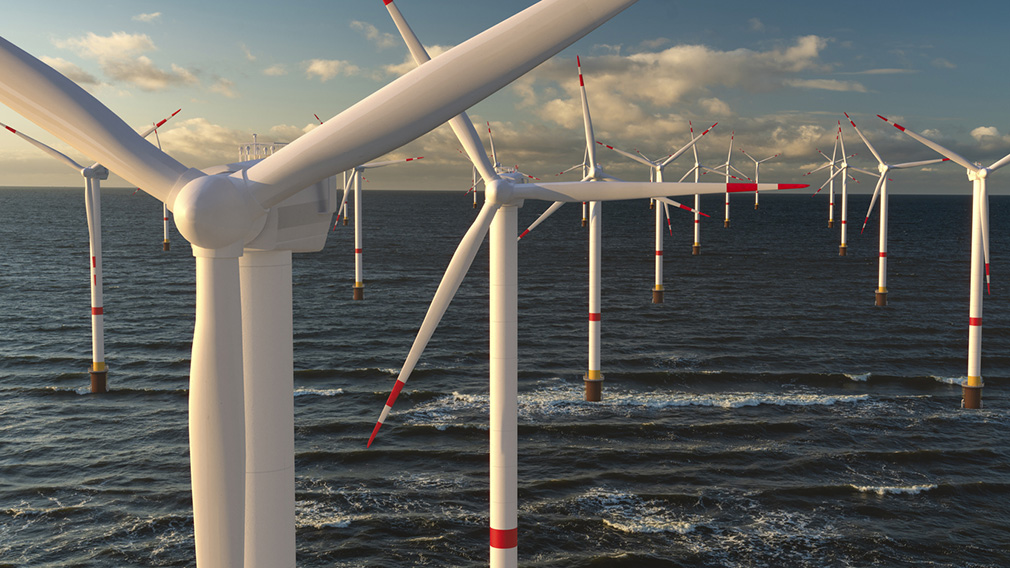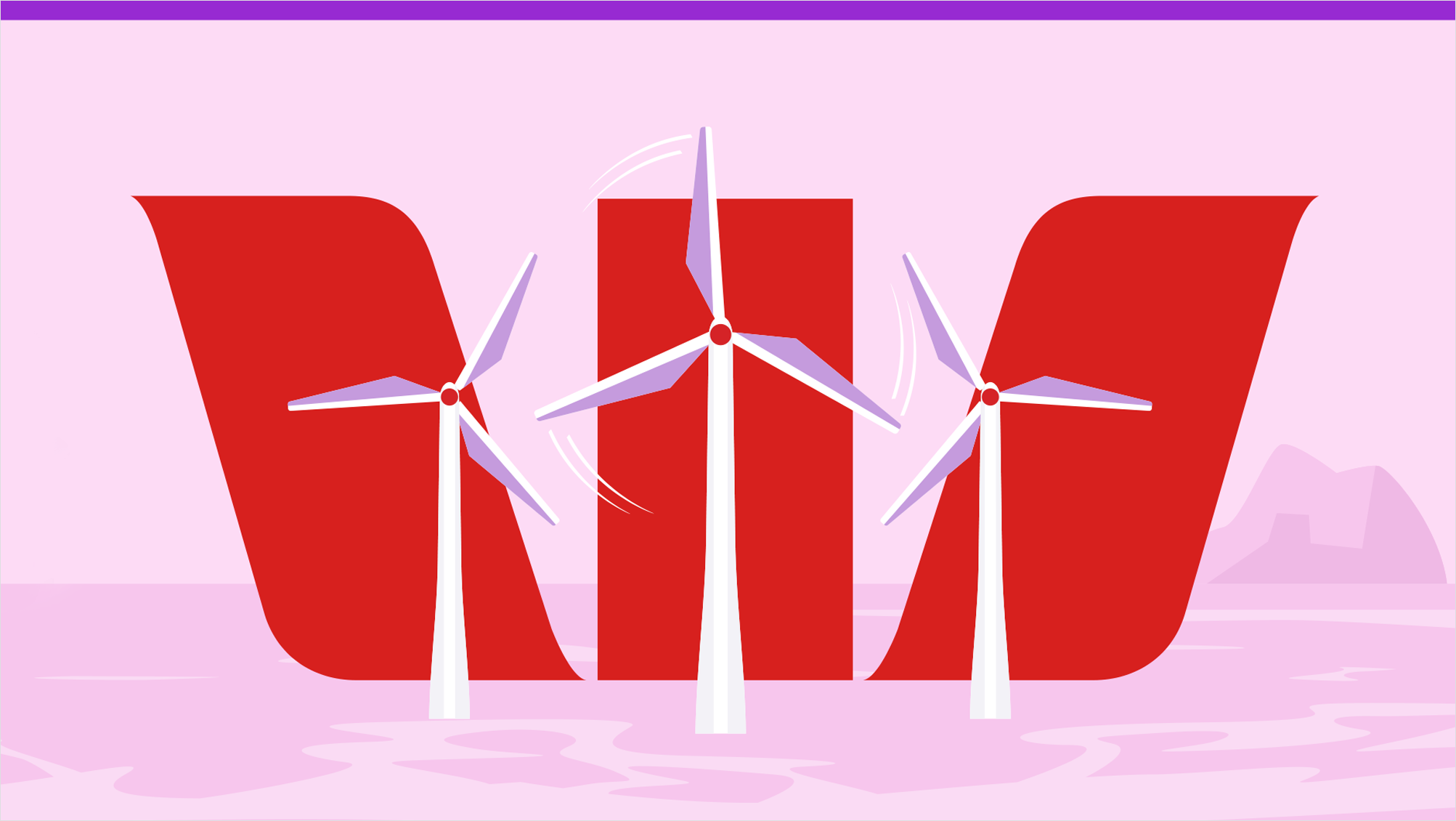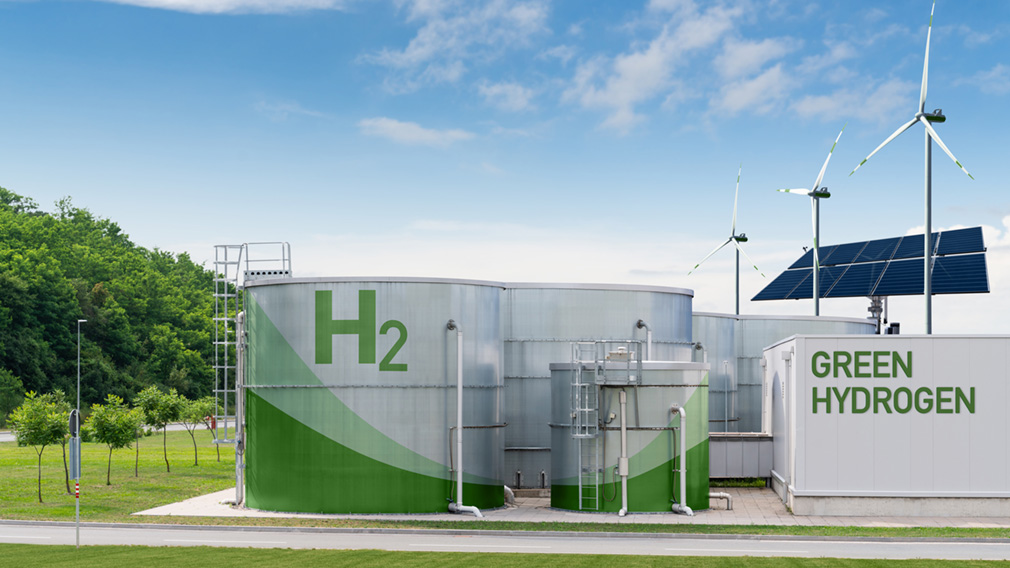Offshore wind: Turning on renewable energy’s next generation
A global market is booming, and developers and investors are eyeing the huge potential of Australia’s world class offshore wind resources as the nascent industry starts to move ahead.

Australia doesn’t yet have any offshore wind electricity generators, but that is set to change in coming years as the Federal Government earmarks six zones for development.
Foreign and local renewable energy developers are gearing up to build offshore wind generation to tap its huge potential in Australia.
Offshore wind electricity generation is a proven technology overseas, but the sector is only just getting underway in Australia. It has several advantages over onshore wind.
Winds generally blow harder and more constantly off the coast than they do on land, and it’s possible to install much larger turbines out at sea. In combination, this makes offshore wind a more efficient resource than onshore wind and creates a more consistent supply of energy.
It can also be built close to end-users, such as in the ocean-near cities, without the need for thousands of kilometers of transmission lines.
And offshore wind projects can be built on a scale that far outstrips onshore wind. Turbines can be hundreds of metres tall and have a generation capacity of up to 15,000 kilowatts – enough electricity to power approximately 20,000 households and save around 38,000 tonnes of carbon dioxide emissions a year, according to The National Offshore Petroleum Safety and Environmental Management Authority (NOPSEMA).
Realising offshore wind potential
NOPSEMA says Australia has “world class offshore wind resources”, mostly in the southern half of the mainland and around Tasmania. It cites estimates from the Global Wind Energy Council that Australia has the potential to generate up to 5,000 gigawatts of electricity from offshore wind, which represents 100 times the installed capacity of Australia’s two largest electricity networks.
Offshore wind is a well-established and proven power source in countries including China, the UK and Germany, but has so far been hampered in Australia by a lack of enabling legislation.
This is changing with the Federal Government creating two offshore wind zones – in the Bass Strait off Gippsland in Victoria late last year, and the Pacific Ocean off the Hunter region in NSW in July – and it’s planning to create four more.
Local players, including Origin Energy, AGL and Macquarie Group, have applied for feasibility licences, the first step in building an offshore wind farm. None have been awarded yet.
“We're really excited about the opportunity for offshore wind both here and abroad,” says Jason Tranter, Global Head of Project Finance, Debt Products at Westpac Institutional Bank.
“The offshore wind market is booming globally. It's in its infancy in the Australian context; it's like solar 15 years ago.”
With the growing momentum for offshore wind development, Tranter says he is having regular conversations with new developers wanting to win feasibility licences and invest.
Making plans to build
Star of the South offshore wind project is planning to install up to 2.2 GW of new capacity in the Bass Strait off Gippsland, enough to power more than 1.2 million homes across Victoria.
Star of the South Chief Executive Charles Rattray says the project has been underway for five years and is Australia’s most advanced offshore wind project, with much of the data required for approvals already collected.
But even so, Rattray says there’s more to be done before Victorians see steel in the water. The project first needs to be granted a feasibility licence, then environmental and planning approvals, and a commercial licence before construction can start. Generation could begin later this decade dependent on approvals and licences, and so on.
Rattray says there are many reasons to build off Gippsland: it has high and constant wind speeds, which also correlate with hot weather; the water isn’t too deep to fix turbines to the seabed; and it is close to existing transmission. “Once you've got your transmission and port set up, you can deliver enormous scale into the grid when you compare it with onshore,” he says.
The project is estimated to cost AUD 8 billion to AUD 10 billion depending on its final size and already has investment from fund manager Copenhagen Infrastructure Partners and Australia’s Cbus Super, which has taken a 10 per cent stake.
Star of the South will need to carefully manage the potential environmental impacts of the project, particularly during construction and, while turbines must be at least 10km from the shore, Rattray says they will be visible.
The project is proposing to install fixed foundation turbines, which will be around 300 metres tall, into the seabed.
Depending on sea depths, other developers’ projects might rely on floating turbines, an emerging technology that will allow turbines to be installed in deeper waters. They can be set up further out to sea and can have a lower environmental impact, but they are an emerging and unproven technology.
Investors and developers lining up
Australia’s state, territory and federal governments’ energy targets, political stability and the huge need to electrify the economy make the country an attractive destination for capital for renewable energy projects. Victoria, for instance, is aiming for at least 2 gigawatts of offshore generation by 2032.
“We’re very confident that investors are there, and in the need to do it,” says Westpac’s Tranter of the potential of offshore wind in Australia. “There’s a long list of investors chasing the offshore wind sector and looking to invest in offshore wind in Australia.” These include Orsted, RWE, DP Energy, Oceanex and Macquarie Group.
The scale of offshore wind projects makes them more efficient than collecting together a lot of smaller renewable projects.
And with no existing offshore wind developments, the field is wide open for developers. The Gippsland zone alone covers 15,000 square kilometres and capacity for several developments.
Offshore wind energy development would get a boost from the declaration of more renewable energy zones and more efficient approvals processes, Tranter says. One complication for the sector is that projects may also require contracts from governments and/or customers to buy the electricity at a set price – known as power purchase agreements (PPAs) – to provide enough certainty for the business case and to underwrite the billions of dollars of investment required for each project.
None of the projects have any requirement for local content of materials or equipment, but Tranter says governments could set content requirements in their own power purchase agreements.
Offshore expertise for renewables’ next stage
Regardless, the developments will create a whole new industry for construction, operation and maintenance of these mega projects.
“You can't operate and maintain these very large projects from a remote location,” Tranter says. “This is going to create a lot of local jobs in order to operate and maintain these projects safely. We will need an entire local supply chain and even a fleet of maintenance barges, requiring an entirely new industry to be established in the region.”
Following its decision to shut its Loy Yang a coal-fired power station in Victoria by 2035, generator and retailer AGL is looking for renewable energy sources, including offshore wind because it can operate for more hours than onshore wind.
Chief Operating Officer Markus Brokhof said typical wind farms onshore in Australia would produce power 28 per cent to 43 per cent of the time, compared to about 50 per cent for offshore wind.
AGL has formed a consortium with global renewables and offshore wind developers and investors Mainstream Renewable Power, Reventus Power and Australia’s DIRECT Infrastructure to apply for licensing for a 2.5 GW wind development offshore of Gippsland, which would on its own replace half of Loy Yang’s capacity.
“While we have extensive experience in onshore wind, we are a newcomer to this,” Brokhof says. “So we wanted to have a consortium of reputable companies which have already built offshore windfarms and have a portfolio.”
Australia will be sourcing far more than know-how from international markets. It’s not the only jurisdiction seeking to exploit offshore wind, so will have to compete for supplies from global equipment manufacturers, Brokhof points out.
A successful energy transition for Australia will need to include offshore wind and foreign investment, he says, adding the government could help this with financial support and by streamlining the approvals process.
What role will hydrogen play in Australia’s future renewable energy mix? Read our new report.
Stay informed with Westpac IQ
Get the latest reports straight to your inbox.
Browse topics
Disclaimer
©2025 Westpac Banking Corporation ABN 33 007 457 141 (including where acting under any of its Westpac, St George, Bank of Melbourne or BankSA brands, collectively, “Westpac”). References to the “Westpac Group” are to Westpac and its subsidiaries and includes the directors, employees and representatives of Westpac and its subsidiaries.
Things you should know
We respect your privacy: You can view our privacy statement at Westpac.com.au. Each time someone visits our site, data is captured so that we can accurately evaluate the quality of our content and make improvements for you. We may at times use technology to capture data about you to help us to better understand you and your needs, including potentially for the purposes of assessing your individual reading habits and interests to allow us to provide suggestions regarding other reading material which may be suitable for you.
This information, unless specifically indicated otherwise, is under copyright of the Westpac Group. None of the material, nor its contents, nor any copy of it, may be altered in any way, transmitted to, copied of distributed to any other party without the prior written permission of the Westpac Group.
Disclaimer
This information has been prepared by the Westpac and is intended for information purposes only. It is not intended to reflect any recommendation or financial advice and investment decisions should not be based on it. This information does not constitute an offer, a solicitation of an offer, or an inducement to subscribe for, purchase or sell any financial instrument or to enter into a legally binding contract. To the extent that this information contains any general advice, it has been prepared without taking into account your objectives, financial situation or needs and before acting on it you should consider the appropriateness of the advice. Certain types of transactions, including those involving futures, options and high yield securities give rise to substantial risk and are not suitable for all investors. We recommend that you seek your own independent legal or financial advice before proceeding with any investment decision. This information may contain material provided by third parties. While such material is published with the necessary permission none of Westpac or its related entities accepts any responsibility for the accuracy or completeness of any such material. Although we have made every effort to ensure this information is free from error, none of Westpac or its related entities warrants the accuracy, adequacy or completeness of this information, or otherwise endorses it in any way. Except where contrary to law, Westpac Group intend by this notice to exclude liability for this information. This information is subject to change without notice and none of Westpac or its related entities is under any obligation to update this information or correct any inaccuracy which may become apparent at a later date. This information may contain or incorporate by reference forward-looking statements. The words “believe”, “anticipate”, “expect”, “intend”, “plan”, “predict”, “continue”, “assume”, “positioned”, “may”, “will”, “should”, “shall”, “risk” and other similar expressions that are predictions of or indicate future events and future trends identify forward-looking statements. These forward-looking statements include all matters that are not historical facts. Past performance is not a reliable indicator of future performance, nor are forecasts of future performance. Whilst every effort has been taken to ensure that the assumptions on which any forecasts are based are reasonable, the forecasts may be affected by incorrect assumptions or by known or unknown risks and uncertainties. The ultimate outcomes may differ substantially from any forecasts.
Conflicts of Interest: In the normal course of offering banking products and services to its clients, the Westpac Group may act in several capacities (including issuer, market maker, underwriter, distributor, swap counterparty and calculation agent) simultaneously with respect to a financial instrument, giving rise to potential conflicts of interest which may impact the performance of a financial instrument. The Westpac Group may at any time transact or hold a position (including hedging and trading positions) for its own account or the account of a client in any financial instrument which may impact the performance of that financial instrument.
Author(s) disclaimer and declaration: The author(s) confirms that (a) no part of his/her compensation was, is, or will be, directly or indirectly, related to any views or (if applicable) recommendations expressed in this material; (b) this material accurately reflects his/her personal views about the financial products, companies or issuers (if applicable) and is based on sources reasonably believed to be reliable and accurate; (c) to the best of the author’s knowledge, they are not in receipt of inside information and this material does not contain inside information; and (d) no other part of the Westpac Group has made any attempt to influence this material.
Further important information regarding sustainability-related content: This material may contain statements relating to environmental, social and governance (ESG) topics. These are subject to known and unknown risks, and there are significant uncertainties, limitations, risks and assumptions in the metrics, modelling, data, scenarios, reporting and analysis on which the statements rely. In particular, these areas are rapidly evolving and maturing, and there are variations in approaches and common standards and practice, as well as uncertainty around future related policy and legislation. Some material may include information derived from publicly available sources that have not been independently verified. No representation or warranty is made as to the accuracy, completeness or reliability of the information. There is a risk that the analysis, estimates, judgements, assumptions, views, models, scenarios or projections used may turn out to be incorrect. These risks may cause actual outcomes to differ materially from those expressed or implied. The ESG-related statements in this material do not constitute advice, nor are they guarantees or predictions of future performance, and Westpac gives no representation, warranty or assurance (including as to the quality, accuracy or completeness of the statements). You should seek your own independent advice.
Additional country disclosures:
Australia: Westpac holds an Australian Financial Services Licence (No. 233714). You can access Westpac’s Financial Services Guide here or request a copy from your Westpac point of contact. To the extent that this information contains any general advice, it has been prepared without taking into account your objectives, financial situation or needs and before acting on it you should consider the appropriateness of the advice.
New Zealand: In New Zealand, Westpac Institutional Bank refers to the brand under which products and services are provided by either Westpac (NZ division) or Westpac New Zealand Limited (company number 1763882), the New Zealand incorporated subsidiary of Westpac ("WNZL"). Any product or service made available by WNZL does not represent an offer from Westpac or any of its subsidiaries (other than WNZL). Neither Westpac nor its other subsidiaries guarantee or otherwise support the performance of WNZL in respect of any such product. WNZL is not an authorised deposit-taking institution for the purposes of Australian prudential standards. The current disclosure statements for the New Zealand branch of Westpac and WNZL can be obtained at the internet address www.westpac.co.nz .
Singapore: This material has been prepared and issued for distribution in Singapore to institutional investors, accredited investors and expert investors (as defined in the applicable Singapore laws and regulations) only. Recipients of this material in Singapore should contact Westpac Singapore Branch in respect of any matters arising from, or in connection with, this material. Westpac Singapore Branch holds a wholesale banking licence and is subject to supervision by the Monetary Authority of Singapore.
U.S.: Westpac operates in the United States of America as a federally licensed branch, regulated by the Office of the Comptroller of the Currency. Westpac is also registered with the US Commodity Futures Trading Commission (“CFTC”) as a Swap Dealer, but is neither registered as, or affiliated with, a Futures Commission Merchant registered with the US CFTC. The services and products referenced above are not insured by the Federal Deposit Insurance Corporation (“FDIC”). Westpac Capital Markets, LLC (‘WCM’), a wholly-owned subsidiary of Westpac, is a broker-dealer registered under the U.S. Securities Exchange Act of 1934 (‘the Exchange Act’) and member of the Financial Industry Regulatory Authority (‘FINRA’). In accordance with APRA's Prudential Standard 222 'Association with Related Entities', Westpac does not stand behind WCM other than as provided for in certain legal agreements between Westpac and WCM andobligations of WCM do not represent liabilities of Westpac. This communication is provided for distribution to U.S. institutional investors in reliance on the exemption from registration provided by Rule 15a-6 under the Exchange Act and is not subject to all of the independence and disclosure standards applicable to debt research reports prepared for retail investors in the United States. WCM is the U.S. distributor of this communication and accepts responsibility for the contents of this communication. Transactions by U.S. customers of any securities referenced herein should be effected through WCM. All disclaimers set out with respect to Westpac apply equally to WCM. If you would like to speak to someone regarding any security mentioned herein, please contact WCM on +1 212 389 1269. Investing in any non-U.S. securities or related financial instruments mentioned in this communication may present certain risks. The securities of non-U.S. issuers may not be registered with, or be subject to the regulations of, the SEC in the United States. Information on such non-U.S. securities or related financial instruments may be limited. Non-U.S. companies may not be subject to audit and reporting standards and regulatory requirements comparable to those in effect in the United States. The value of any investment or income from any securities or related derivative instruments denominated in a currency other than U.S. dollars is subject to exchange rate fluctuations that may have a positive or adverse effect on the value of or income from such securities or related derivative instruments.
The author of this communication is employed by Westpac and is not registered or qualified as a research analyst, representative, or associated person of WCM or any other U.S. broker-dealer under the rules of FINRA, any other U.S. self-regulatory organisation, or the laws, rules or regulations of any State. Unless otherwise specifically stated, the views expressed herein are solely those of the author and may differ from the information, views or analysis expressed by Westpac and/or its affiliates.
UK and EU: The London branch of Westpac is authorised in the United Kingdom by the Prudential Regulation Authority (PRA) and is subject to regulation by the Financial Conduct Authority (FCA) and limited regulation by the PRA (Financial Services Register number: 124586). The London branch of Westpac is registered at Companies House as a branch established in the United Kingdom (Branch No. BR000106). Details about the extent of the regulation of Westpac’s London branch by the PRA are available from us on request.
Westpac Europe GmbH (“WEG”) is authorised in Germany by the Federal Financial Supervision Authority (‘BaFin’) and subject to its regulation. WEG’s supervisory authorities are BaFin and the German Federal Bank (‘Deutsche Bundesbank’). WEG is registered with the commercial register (‘Handelsregister’) of the local court of Frankfurt am Main under registration number HRB 118483. In accordance with APRA’s Prudential Standard 222 ‘Association with Related Entities’, Westpac does not stand behind WEG other than as provided for in certain legal agreements (a risk transfer, sub-participation and collateral agreement) between Westpac and WEG and obligations of WEG do not represent liabilities of Westpac.
This communication is not intended for distribution to, or use by any person or entity in any jurisdiction or country where such distribution or use would be contrary to local law or regulation. This communication is not being made to or distributed to, and must not be passed on to, the general public in the United Kingdom. Rather, this communication is being made only to and is directed at (a) those persons falling within the definition of Investment Professionals (set out in Article 19(5) of the Financial Services and Markets Act 2000 (Financial Promotion) Order 2005 (the “Order”)); (b) those persons falling within the definition of high net worth companies, unincorporated associations etc. (set out in Article 49(2)of the Order; (c) other persons to whom it may lawfully be communicated in accordance with the Order or (d) any persons to whom it may otherwise lawfully be made (all such persons together being referred to as “relevant persons”). Any person who is not a relevant person should not act or rely on this communication or any of its contents. In the same way, the information contained in this communication is intended for “eligible counterparties” and “professional clients” as defined by the rules of the Financial Conduct Authority and is not intended for “retail clients”. Westpac expressly prohibits you from passing on the information in this communication to any third party.
This communication contains general commentary, research, and market colour. The communication does not constitute investment advice. The material may contain an ‘investment recommendation’ and/or ‘information recommending or suggesting an investment’, both as defined in Regulation (EU) No 596/2014 (including as applicable in the United Kingdom) (“MAR”). In accordance with the relevant provisions of MAR, reasonable care has been taken to ensure that the material has been objectively presented and that interests or conflicts of interest of the sender concerning the financial instruments to which that information relates have been disclosed.
Investment recommendations must be read alongside the specific disclosure which accompanies them and the general disclosure which can be found here. Such disclosure fulfils certain additional information requirements of MAR and associated delegated legislation and by accepting this communication you acknowledge that you are aware of the existence of such additional disclosure and its contents.
To the extent this communication comprises an investment recommendation it is classified as non-independent research. It has not been prepared in accordance with legal requirements designed to promote the independence of investment research and therefore constitutes a marketing communication. Further, this communication is not subject to any prohibition on dealing ahead of the dissemination of investment research.



